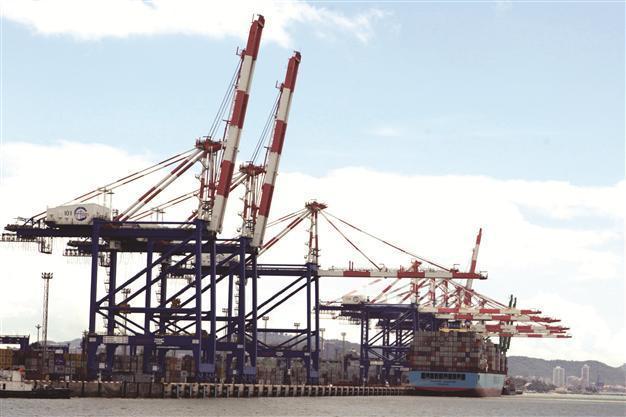China’s trade decelerates in sign of further global fragility
BEIJING - The Associated Press

A container ship docks at a port in Xiamen, in southeastern China’s Fujian province. China’s exports were $176.9 billion in July. AP photo
China’s trade growth plunged even more sharply than forecast in July in a new sign of global economic weakness.Exports rose just 1 percent over a year earlier, down from June’s 11.3 percent rate and below forecasts of about 5 percent, data showed on Aug. 10. Import growth fell to 4.7 percent from the previous month’s 6.3 percent and also below forecasts.
The figures follow disappointing data on Aug. 9 showing weak Chinese factory production and retail sales in July. They add to signs the world’s second-largest economy is still struggling with its deepest downturn since the 2008 global crisis despite repeated government stimulus efforts.
The latest signs of weakness have prompted calls for still more stimulus measures. Beijing has cut interest rates twice since the start of June and is pumping money into the economy through higher spending on building low-cost housing and other public works.
Economic growth fell to a three-year low of 7.6 percent in the quarter ending in June. The International Monetary Fund and private sector analysts have trimmed their forecasts for the year but say growth should be about 8 percent - above the official 7.5 percent target but below the double-digit rates of recent years.
The slowdown is politically dangerous for the ruling Communist Party because it raises the risk of job losses and unrest at a time when the ruling party is trying to enforce calm ahead of a handover of power this year to younger leaders. Export industries employ millions of workers and weak sales, coupled with higher costs, have led to a wave of bankruptcies.
Steady fall in trade
China’s trade growth has fallen steadily this year as global demand for its exports cooled and efforts to boost domestic consumption have failed to gain traction as fast as the government hoped.
In July, its global trade surplus narrowed by 20.3 percent from July 2011 to $25.1 billion but was this year’s second biggest after June’s $31.7 billion.
Exports were $176.9 billion while imports were $151.8 billion.
The trade surplus with the 27-nation European Union, China’s biggest trading partner, narrowed by 37.9 percent to $10.8 billion, reflecting sluggish European demand due to the continent’s debt crisis. The surplus with the United States narrowed by 4.8 percent to $19.9 billion.
Beijing has set a goal of increasing total trade by 10 percent this year, a target that looks increasingly hard to meet. Trade grew 9.2 percent for the first half of the year but the rate fell to 7.1 percent for the first seven months.
Hong Kong sees shrinkage in second quarter
HONG KONG – Agence France-Presse
Hong Kong’s economy shrank 0.1 percent in the second quarter due to weak exports amid slowing growth in the global economy, the government said on Aug. 10. The contraction in the second quarter was worse than the median forecast of 0.1 percent growth by five economists in a Dow Jones Newswires survey.
“On a seasonally adjusted quarter-to-quarter comparison, real GDP dipped marginally by 0.1 percent in the second quarter, following 0.6 percent growth in the first quarter,” an official statement said. Compared with the same period last year, gross domestic product expanded 1.1 percent, helped by a lower base of comparison a year earlier when a earthquake and tsunami in Japan disrupted the country’s export industry.
















